

The Moon is the only natural satellite of the Earth (Scientific America july 1998). The Moon is called Luna by the Romans, Selene and Artemis by the Greeks, and many other names in mythologies. Even African tribes have a name for the moon, it is called Wather by the Housa Tribe of Africa where this writer comes from. All cultures take note of the Moon. Since the beginning of time, man has been obsessed with the Moon and knowing all we can about it. This may be because the Moon is the closest object to us in our Solar System. Researchers hope that by studying the Moon that we will be able to learn more about the Earth and the other planets in the Solar System. Scientists have wondered many things about the Moon. For instance, is there water (or ice) on the moon? What is the chemical make-up of the Moon? What caused the craters on the Moon? Was there volcanic activity on the Moon? Many of these questions have been answered and then many more have been raised. More answers to our questions about the Moon are beginning to come forward with careful study of the Moon. Much of the recent research is being done with the help of two spacecrafts, the Clementine and the Lunar Prospector.


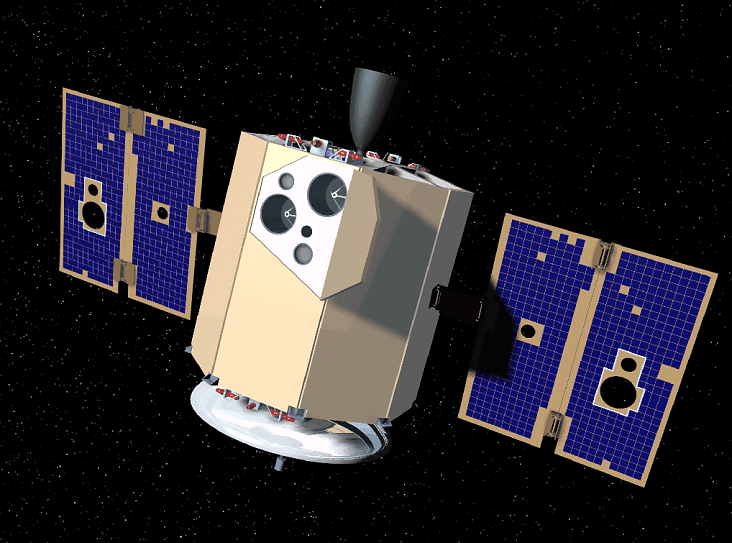
The Clementine spacecraft was originally designed to track missiles and test "Star War" sensors (Scientific America July 1998). This spacecraft cost the Pentagon $75 million,(Scientific America July 1998). it was designed in such a way to enable long-duration deep-space missions at low cost using significantly advanced lightweight satellite technology.(Scientific America July 1998). However, the spacecraft did not have any instruments designed to gather information about the Moon. Yet, Deputy Project Manager, Stewart Nozette talked the Ballistic Missile Defense Organization into using the spacecraft transmitter to beam radio waves into the dark regions of the South Pole of the Moon,(Scientific America July 1998). as well as into the lighted areas of the Moon. ( Scientific America July 1998). This improvised experience using the radio waves allowed for the discovery of possible ice on the Moon. In April of 1994, when the Clementine was directly in line with Earth, the spacecraft swept over an area of the South Pole of the Moon approximately 200 km across. The radar echo of that orbit was altered in ways that were consistent with the existence of ice. ( Scientific America July 1998).
The existence of ice is supported by the fact that this area of the Moon was confirmed by Clementine to be a permanent dark area. These dark area were not confirmed until the Clementine made its pass and recordings of the Moon. The dark areas were confirmed by the observation of the Moon's North and South Poles for one entire lunar day - which is 29.5 Earth days. The fact that this area is never touched by sunlight its temperatures would never rise about 280 degree below zero F. This area is known at the South Pole-Aitken basin, which is an impact crater over 2,500 km in diameter and up to 13 km deep. This crater is the largest and deepest in the Solar System. The basin is centered at 50 degrees south latitude and is so large that it encompasses the South Pole of the Moon. ( Scientific America July 1998). Even after the readings from the Clementine, many researches are still skeptical as to whether or not ice actually exists on the Moon.
Clementine was launched on January 25, 1994, from Vandenburg
Air Force Base aboard a Titan IIG rocket. After passing close by the Earth
two times, the spacecraft was able to get into a position to begin mapping
the moon. This position was achieved on February 19, 1994. The mapping
of the Moon took place over approximately two months in systematic mapping
passes over the Moon. The observations of the Moon
were organized into the following four periods:
1) The First Observational Period (Orbits
1-31) was the shakedown and testing period where the spacecraft observation
sequences were tested and refined. Observations of special targets, such
as Apollo landing sites, were obtained during this period.
2) The Second Observational Period (Orbits
32-168) consisted of the first month's systematic mapping passes. This
period started on February 26th and ended on March 26, 1994.
3) The Third Observational Period (Orbits
169-297) consisted of the second month's systematic mapping passes. This
period started on March 26th and ended on April 21, 1994.
4) Fourth Observational Period (Orbits 298-348) were
used to make observations to fill in gaps left from the other passes, obtain
observations of special targets, obtain stereo observations over Orientale
Basin, and obtain calibration data.
The Clemetine was unable to complete the planned close
pass on the near-Earth asteroid Geography, due to an onboard malfunction
which resulted in the activation of several altitude thrusters. This depleted
all the remaining fuel and left the spacecraft spinning at 80 revolutions
per minute. ( Scientific America July 1998).
The Clementine mission carried four cameras, one with
a laser ranging system. The spacecraft also had two star tracker cameras,
used mainly for attitude
determination, but they also served as wide-field cameras
for various scientific and operational purposes. All sensors on the spacecraft
met or exceeded expectations
in their performance.

Image: National Space Science Data Center
http://nssdc.gsfc.nasa.gov/cgi-bin/database/www-nmc?94-004A-07
Star Tracker Camera
The Star Tracker provides an inertial reference for the
spacecraft by comparison of star-field images with an onboard star map.
Two of these cameras were flown on the Clementine Mission. [Instrument
Details at NSSDC]

Image: National Space Science Data Center
http://nssdc.gsfc.nasa.gov/cgi-bin/database/www-nmc?94-004A-01
Ultraviolet/Visible Camera
This medium-resolution camera uses CCD technology and
operates in the near-ultraviolet and visible region of the spectrum. Combined
with a six-position spectral filter wheel, this sensor
was designed for mineralogical studies of the Moon. [Instrument Details
at NSSDC]

Image: National Space Science Data Center
http://www-phys.llnl.gov:80/clementine/CLEMTINE.GIF
Near-Infrared Camera
This camera provided images in the 1-to-3-micrometer wavelength region at medium resolution. Combined with a six-position spectral filter wheel, this camera was for mineralogical studies. [Instrument Details at NSSDC]

Image: National Space Science Data Center
http://www-phys.llnl.gov:80/clementine/CLEMTINE.GIF
High-Resolution Camera
This camera operated at visible wavelengths with CCD technology combined with an image intensifier and a six-position spectral filter wheel. It provided higher-resolution images free of spacecraft motion blur. [Instrument Details at NSSDC]

Image: National Space Science Data Center
http://www-phys.llnl.gov:80/clementine/CLEMTINE.GIF
LIDAR System
This system was used to obtain altitude measurements during mapping orbits around the Moon. [Instrument Details at NSSDC]

Image: National Space Science Data Center
http://www-phys.llnl.gov:80/clementine/CLEMTINE.GIF
Long-Wave Infrared Camera
This lightweight camera operated in the thermal infrared
region of the spectrum. It was used to measure the thermal emission from
the Moon. [Instrument Details at NSSDC]
Clementine Images on the Moon
Introduction
These images are returned by the Clementine Mission and processed under the direction of Dr. Paul Spudis.
1. Clementine Topographic Map of the Moon (Near Side/Far Side)

Image Courtesy: National Space Science Data Center
http://www-phys.llnl.gov:80/clementine/CLEMTINE.GIF
2. Clementine Topographic Map of the Moon (East/West)
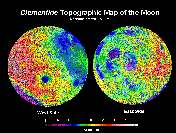
Image Courtesy: National Space Science Data Center
http://www-phys.llnl.gov:80/clementine/CLEMTINE.GIF
Introduction. Clementine Iron Map of the Moon
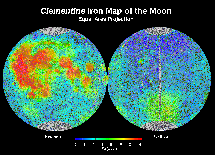
Image Courtesy: National Space Science Data Center
http://www-phys.llnl.gov:80/clementine/CLEMTINE.GIF
4. Clementine Titanium Map of the Moon

Image Courtesy: National Space Science Data Center
http://www-phys.llnl.gov:80/clementine/CLEMTINE.GIF
5. Clementine Albedo Map of the Moon
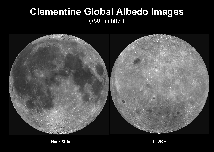
Image Courtesy: National Space Science Data Center
http://www-phys.llnl.gov:80/clementine/CLEMTINE.GIF

Image Courtesy: National Space Science Data Center
http://www-phys.llnl.gov:80/clementine/CLEMTINE.GIF
6. Earth Rise from the Moon's North Pole
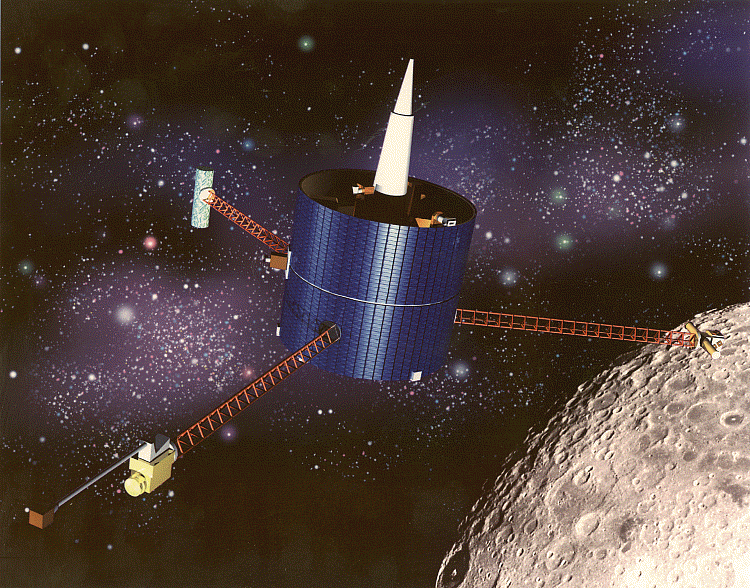
The Prospector is a graphite-epoxy drum, 1.4 meters in diameter and 1.22 meters high with three radial instrument booms. It will be spin-stablized and controlled by 6 hydrazine mono propellant 22-Newton thrusters. The power system consists of body mounted solar cells and 15 amp-hr NiH batteries. Communications are through two S-band transponders and a slotted, phased-array medium gain antenna and omnidirectional low-gain antenna. One of the most unique features of this spacecraft is its lack of on-board computer. (Scientific America July 1998).
The Lunar Prospector will attempt to support the findings
of the Clementine, using different techniques. The Lunar Prospector will
use the Neutron Spectrometer (NS) to measure the amount of hydrogen on
the Moon's surface. This will then be used to directly infer the presence
or absence of ice in the Polar Regions of the Moon.
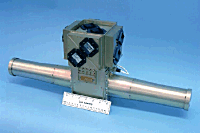
Image Courtesy: National Space Science Data Center
http://nssdc.gsfc.nasa.gov/cgi-bin/database/www-nmc?98-001A
The Lunar Prospector Neutron Spectrometer (NS) is designed
to detect minute amounts of water or ice which may exist on the Moon. It
can detect water or ice at a level of less than 0.01%. The Moon has a number
of permanently shadowed craters near the poles with continuous temperatures
of -190 degrees C. These craters may act as cold-traps for water coming
from comets and meteoroids which strike the Moon. Any water from these
bodies which found its way into these "cold-traps" or craters could become
permanently frozen. The NS will also be used to measure the abundance of
solar wind implanted hydrogen. The neutron spectrometer is a thin cylinder
collocated with the Alpha Particle Spectrometer at
the end of one of the three radial Lunar Prospector science booms. The
instrument has a surface resolution of 150 km. For the polar ice studies,
the NS will examine the poles to 80 degrees latitude with a sensitivity
of at least 10 ppm of hydrogen. For the implanted hydrogen studies, the
NS will examine the entire globe with a sensitivity of 50 ppm.
The neutron spectrometer consists of two canisters each
containing helium-3 and an energy counter. Any neutrons colliding with
the helium atoms will give an energy signature which will be detected and
counted. One of the canisters is wrapped in cadmium and one in tin. The
cadmium screens out thermal (low energy or slow-moving) neutrons while
the tin does not. Thermal neutrons are cosmic-ray generated neutrons which
have lost much of their energy in collisions with hydrogen atoms. Differences
in the counts between the two canisters indicate the number of thermal
neutrons detected, which in turn indicates the amount of hydrogen on the
Moon's crust at a given location. Large quantities of hydrogen would be
due to the presence of water.
Two of the other experiements from the Prospector are
listed below:

Image Courtesy: National Space Science Data Center
http://nssdc.gsfc.nasa.gov/cgi-bin/database/www-nmc?98-001A
The Electron Reflectometer (ER) is designed to collect
information on the lunar remnant paleomagnetic fields. The ER will be used
to attempt to map the weak localized magnetic fields on the Moon's surface.
Additionally, this information may provide data on the origin of the localized
magnetic fields, allow for possible examination of the distribution of
minerals on the Moon's surface and assist in determining the size and composition
of the Moon's core.
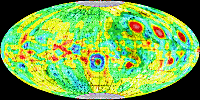
Image Courtesy: National Space Science Data Center
http://nssdc.gsfc.nasa.gov/cgi-bin/database/www-nmc?98-001A
The Lunar Prospector will also be conducting a Doppler
Gravity Experiment to learn about the surface and internal mass distribution
of the Moon. Estimates of the surface and internal mass distribution of
the Moon, gives us information on the crust, lithosphere, and internal
structure of the Moon. Such experiments will provide the first data of
the Moon's gravity from a low polar orbit.
It is clear from the money that is spent on studing the
Moon, that even today people are still curious about the moon. The Clementine
offered us new information about our Moon. The hopes of most researchers
are that the Prospector will confirm finding of the Clementine, as well
as provide more information about the Moon. Why is all this so important?
Maybe the Future will tell us.